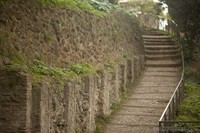Historic Center of Rome, part 2
Photos of the Roman forum and the Imperial Fora in Rome's historic center. You can see the temple of the Dioscurs, details of the Arch of Titus, as well as the statues in the Campidoglio, next to the Roman forum.
Church of San Bonaventura al Palatino
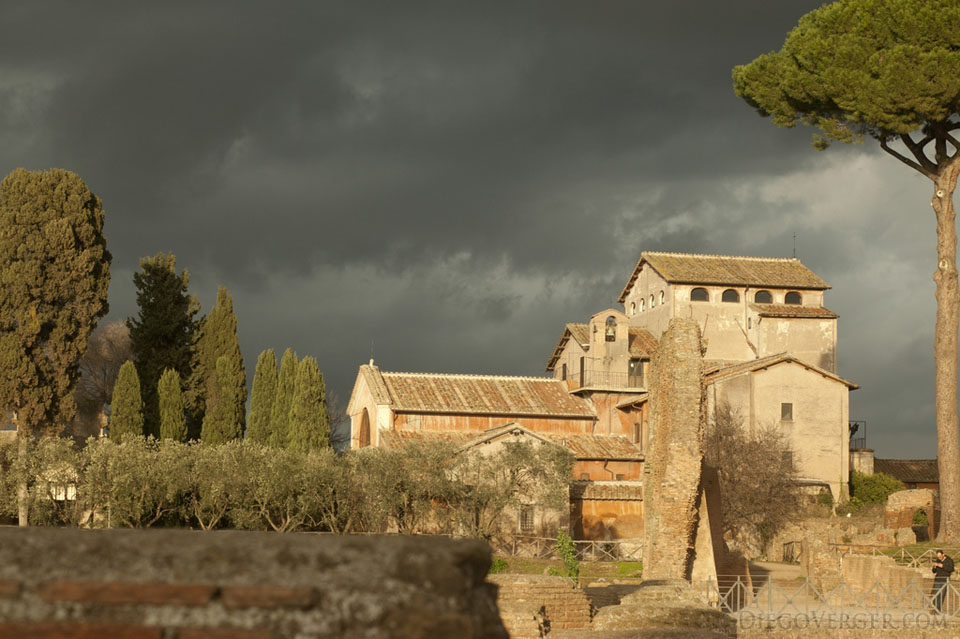 The Church of San Bonaventura al Palatino is located at the top of this hill and dates back to 1625.
The Church of San Bonaventura al Palatino is located at the top of this hill and dates back to 1625.
Passageway of the Arch of Titus
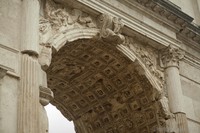 On the ceiling of the passageway of the Arch of Titus, you can see a depiction of the apotheosis or deification of Titus with an eagle. The columns that adorn the sides are of the composite order, as it was customary in memorial buildings of the time.
On the ceiling of the passageway of the Arch of Titus, you can see a depiction of the apotheosis or deification of Titus with an eagle. The columns that adorn the sides are of the composite order, as it was customary in memorial buildings of the time.
Spoils of Jerusalem relief of the Arch of Titus
The Arch of Titus is another triumphal arch located in the Roman Forum, near the Colosseum. This is a detail of the relief in the passageway of the Arch of Titus representing the Menorah scene, related to the siege of Jerusalem in the year 70, where soldiers take the spoils of the Jewish temple in Jerusalem. The arch was commissioned by Titus’s brother, Domitian, to commemorate the "victories" of Titus.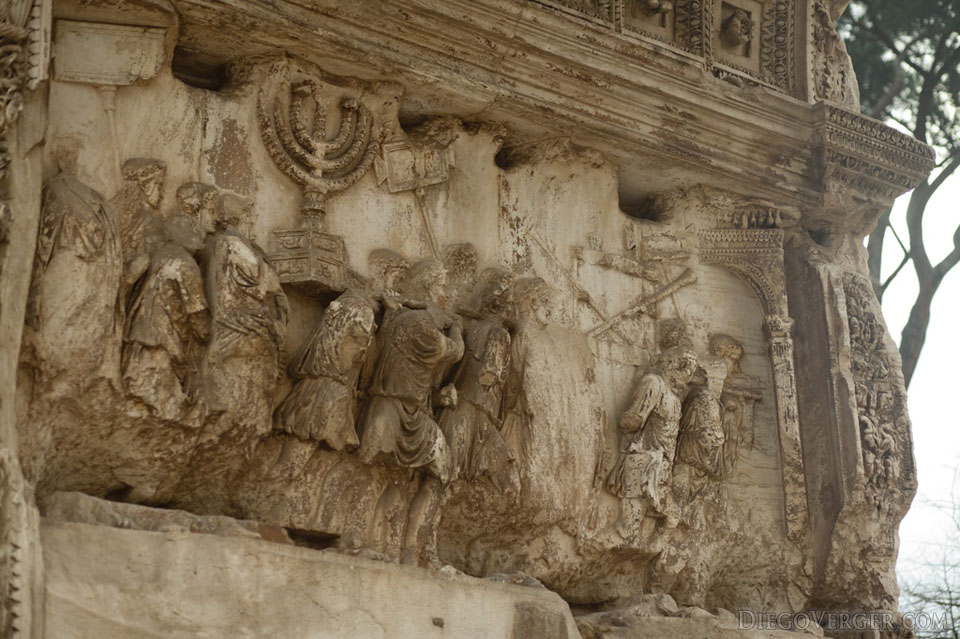
Temple of the Dioscurs
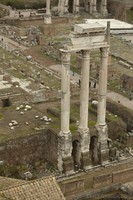 The temple of the Dioscurs, or temple of Castor and Pollux, with its three still standing columns in the Roman forum.
The temple of the Dioscurs, or temple of Castor and Pollux, with its three still standing columns in the Roman forum.
Temple of Caesar and basilica Emilia
 Photo of the Roman forum, with the ruins of the temple of Caesar in the foreground on the left, and the remains of the basilica Emilia behind it, on the center of the image.
Photo of the Roman forum, with the ruins of the temple of Caesar in the foreground on the left, and the remains of the basilica Emilia behind it, on the center of the image.
Palatine hill
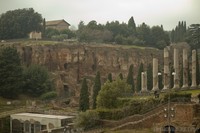 Palatine hill as seen from the Colosseum; and to the right, the colossal columns of the Sacra street which leads to the Roman forum and the Arch of Titus, included in other pictures. The building at the top of the Palatine hill is part of the church of San Sebastiano al Palatino.
Palatine hill as seen from the Colosseum; and to the right, the colossal columns of the Sacra street which leads to the Roman forum and the Arch of Titus, included in other pictures. The building at the top of the Palatine hill is part of the church of San Sebastiano al Palatino.
Roman forum and Vittorio Emanuele II monument
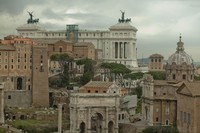 In this photo you can see several structures in or around the Roman forum. The Arch of Titus is located below on the left. Also in the foreground, on the bottom right of the photo, the building known as the Curia Julia, or Senate House, commissioned by Julius Caesar. Behind that building, and rising above, the dome and façade of the church of Saint Luke and Saint Martina. On the top left, beyond the Roman forum, the tallest building corresponds to part of the terrace of the Quadrigas on top of the monument built in honor of Vittorio Emanuele II, first king of united Italy. On the middle right of the photo you can see the dome of the Valentini palace, and the figure that stands out on its left, above the horizon, is the statue on the column of Trajan, in the Trajan forum.
In this photo you can see several structures in or around the Roman forum. The Arch of Titus is located below on the left. Also in the foreground, on the bottom right of the photo, the building known as the Curia Julia, or Senate House, commissioned by Julius Caesar. Behind that building, and rising above, the dome and façade of the church of Saint Luke and Saint Martina. On the top left, beyond the Roman forum, the tallest building corresponds to part of the terrace of the Quadrigas on top of the monument built in honor of Vittorio Emanuele II, first king of united Italy. On the middle right of the photo you can see the dome of the Valentini palace, and the figure that stands out on its left, above the horizon, is the statue on the column of Trajan, in the Trajan forum.
Panoramic view over the Roman forum and surrounding structures
In this photo it can be better appreciated the size of the Vittorio Emanuele II monument with the terrace of the Quadrigas, as well as the Tabularium building on the left. Between the Tabularium and the Vittorio Emanuele II monument, you can see part of the Basilica of Santa Maria in Ara coeli (St. Mary of the Altar of Heaven). On the right of the photo is the church of St. Luke and St. Martina, and lastly, on the bottom center, the Arch of Titus.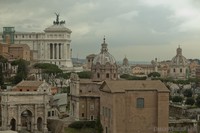
Roman forum ruins
 In the Roman Forum there is a high density of ruins from Imperial temples and palaces.
In the Roman Forum there is a high density of ruins from Imperial temples and palaces.
Colosseum from the Palatine
View of the Colosseum from the Palatine hill. From this angle you can see the exterior and interior of the external wall of the Colosseum.
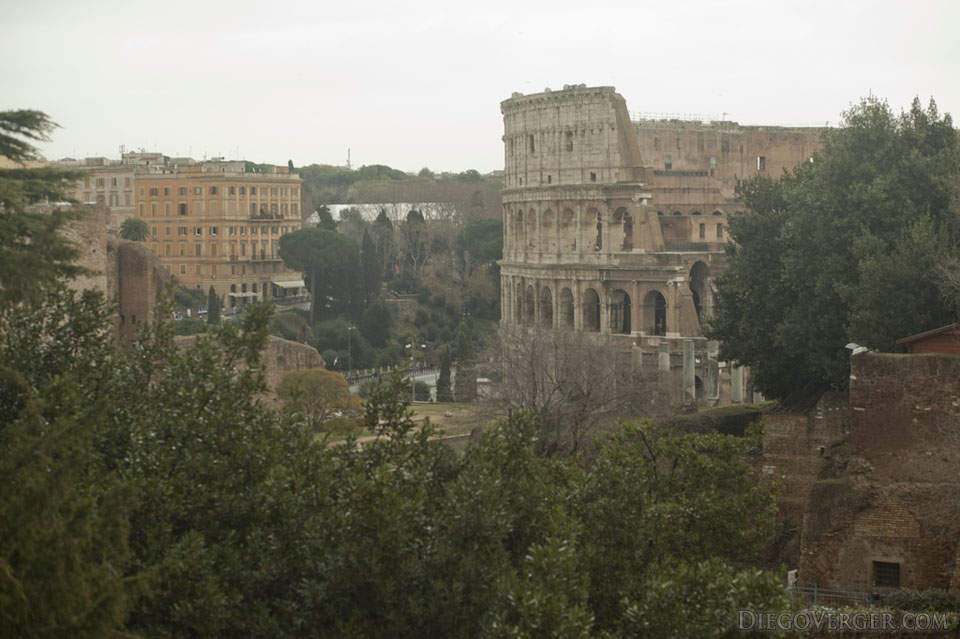
Ruins next to the Domus Flavia
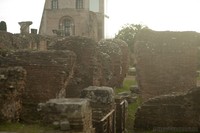 These ruins are between the Domus Flavia, or Flavian Palace, and the house of Livia in the Palatine.
These ruins are between the Domus Flavia, or Flavian Palace, and the house of Livia in the Palatine.
Church of San Bonaventura
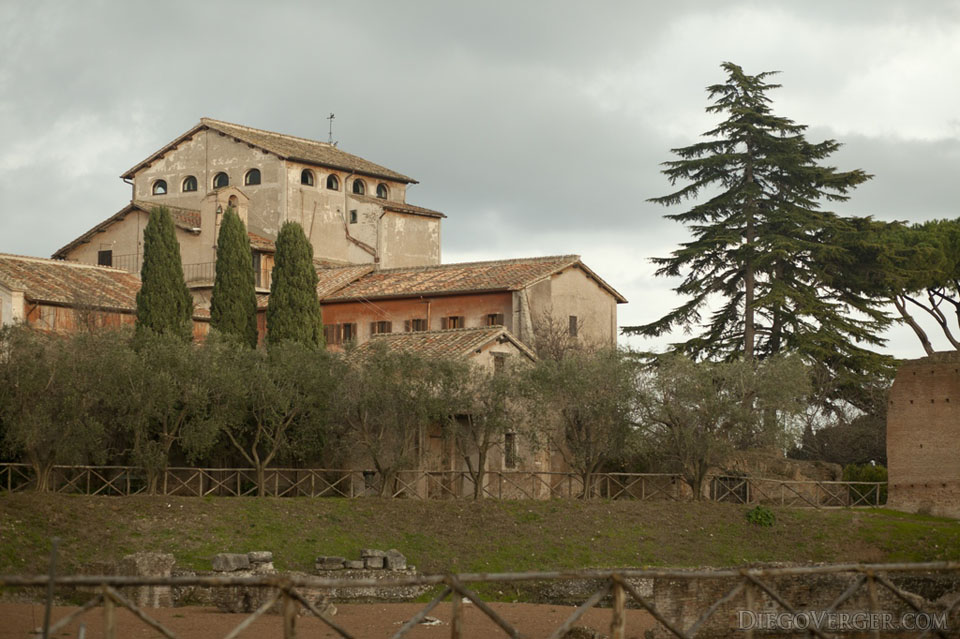 Another view of the church of San Bonaventura al Palatino framed with stormy sky.
Another view of the church of San Bonaventura al Palatino framed with stormy sky.
Ruins next to the Hippodrome of Domitian
 Ruins of a building located next to the Hippodrome of Domitian on the Palatine hill.
Ruins of a building located next to the Hippodrome of Domitian on the Palatine hill.
Domitian stadium
 These are some of the still standing structures that surround the stadium of Domitian. On the bottom, the pillars and the edge of the oval structure of the stadium that still persist today.
These are some of the still standing structures that surround the stadium of Domitian. On the bottom, the pillars and the edge of the oval structure of the stadium that still persist today.
Statue of the goddess Rome
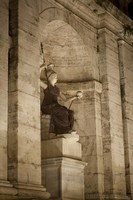 This is the main statue in the fountain of the goddess Rome in the Campidoglio square. The design of the original fountain was much more complex, but underwent several modifications and adjustments. In fact, in 1536 there was no water supply for a fountain, so Michelangelo’s original design of the Campidoglio did not include this fountain. The design of this particular fountain was assigned to Matteo Bartolani da Castello and was built in 1588.
This is the main statue in the fountain of the goddess Rome in the Campidoglio square. The design of the original fountain was much more complex, but underwent several modifications and adjustments. In fact, in 1536 there was no water supply for a fountain, so Michelangelo’s original design of the Campidoglio did not include this fountain. The design of this particular fountain was assigned to Matteo Bartolani da Castello and was built in 1588.
Statue of the "Tiber" river
At the sides of the fountain of the goddess Rome on the Campidoglio there are two statues represening the Nile and Tiber rivers. The colossus in this picture represents the Tiber, and the children below on the left represent the twins Romulus and Remus, playing with the she-wolf who, according to legend, nursed and protected them. Before the wolf there was a tiger, and the statue did not represent the Tiber but the Tigris river.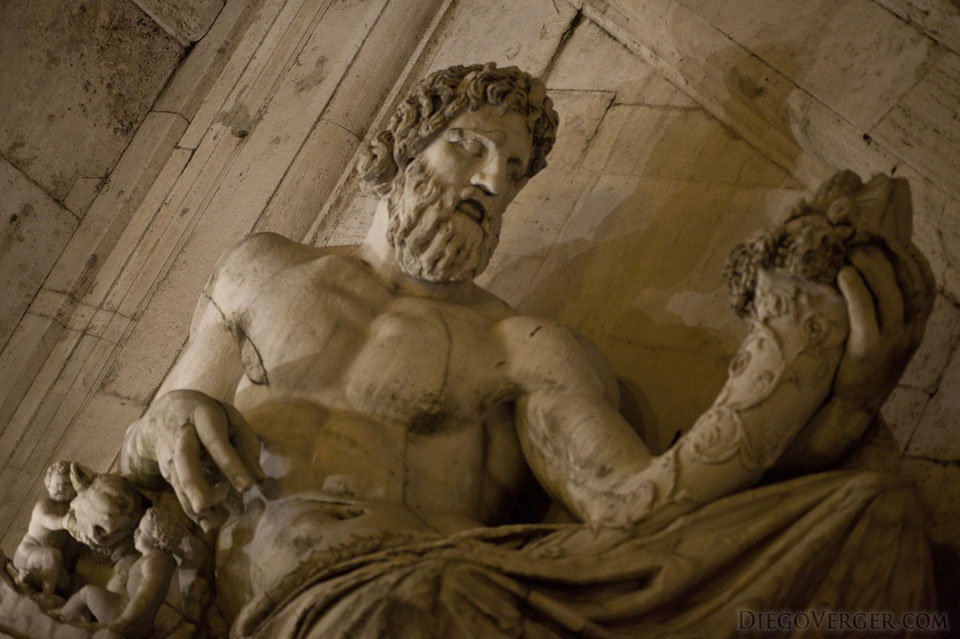
Detail of the "Nile" river statue
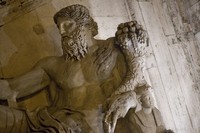 This is the statue on the left of the fountain of the goddess Rome in the Campidolgio, which represents the Nile river. The giant rests on a sphinx and holds a cornucopia, or horn ("cornu") of abundance ("copiae").
This is the statue on the left of the fountain of the goddess Rome in the Campidolgio, which represents the Nile river. The giant rests on a sphinx and holds a cornucopia, or horn ("cornu") of abundance ("copiae").
Statue of the "Nile" river
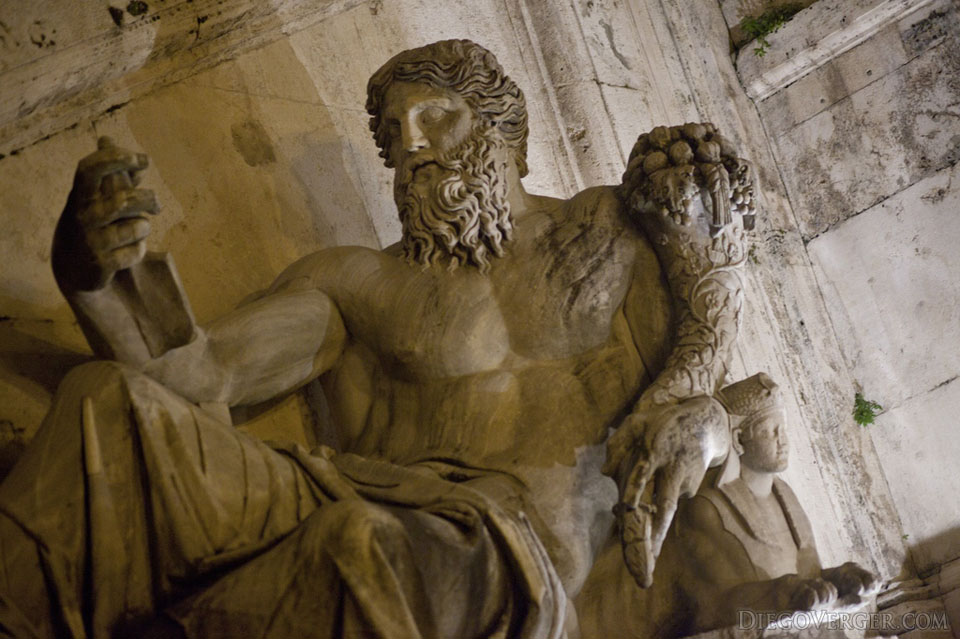 Another view of the statue of the Nile river, part of the fountain of the goddess Rome, in the Campidoglio.
Another view of the statue of the Nile river, part of the fountain of the goddess Rome, in the Campidoglio.
Media (19)
 Church of San Bonaventura al Palatino
Church of San Bonaventura al Palatino
 Passageway of the Arch of Titus
Passageway of the Arch of Titus
 Spoils of Jerusalem relief of the Arch of Titus
Spoils of Jerusalem relief of the Arch of Titus
 Temple of the Dioscurs
Temple of the Dioscurs
 Temple of Caesar and basilica Emilia
Temple of Caesar and basilica Emilia
 Palatine hill
Palatine hill
 Roman forum and Vittorio Emanuele II monument
Roman forum and Vittorio Emanuele II monument
 Panoramic view over the Roman forum and surrounding structures
Panoramic view over the Roman forum and surrounding structures
 Roman forum ruins
Roman forum ruins
 Colosseum from the Palatine
Ancient stairs of the Palatine - Historic Center of Rome, part 2
Ancient stairs of the Palatine
Ruins next to the Domus Flavia - Historic Center of Rome, part 2
Ruins next to the Domus Flavia
Church of San Bonaventura - Historic Center of Rome, part 2
Church of San Bonaventura
Ruins next to the Hippodrome of Domitian - Historic Center of Rome, part 2
Ruins next to the Hippodrome of Domitian
Domitian stadium - Historic Center of Rome, part 2
Domitian stadium
Statue of the goddess Rome - Historic Center of Rome, part 2
Statue of the goddess Rome
Statue of the Tiber river - Historic Center of Rome, part 2
Statue of the Tiber river
Statue of the Nile river - Historic Center of Rome, part 2
Statue of the Nile river
Statue of the Nile river - Historic Center of Rome, part 2
Statue of the Nile river
Colosseum from the Palatine
Ancient stairs of the Palatine - Historic Center of Rome, part 2
Ancient stairs of the Palatine
Ruins next to the Domus Flavia - Historic Center of Rome, part 2
Ruins next to the Domus Flavia
Church of San Bonaventura - Historic Center of Rome, part 2
Church of San Bonaventura
Ruins next to the Hippodrome of Domitian - Historic Center of Rome, part 2
Ruins next to the Hippodrome of Domitian
Domitian stadium - Historic Center of Rome, part 2
Domitian stadium
Statue of the goddess Rome - Historic Center of Rome, part 2
Statue of the goddess Rome
Statue of the Tiber river - Historic Center of Rome, part 2
Statue of the Tiber river
Statue of the Nile river - Historic Center of Rome, part 2
Statue of the Nile river
Statue of the Nile river - Historic Center of Rome, part 2
Statue of the Nile river
